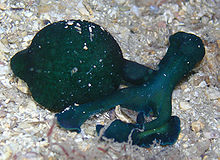Luigi Rolando
Luigi Rolando (born June 16, 1773 in Turin , † April 20, 1831 ibid) was an Italian anatomist and physiologist .
Life
After the early death of his father, Rolando was raised by his uncle, the priest Antonio Maffei. He studied philosophy and medicine in his Piedmontese hometown. He received his doctorate in 1793 (with a dissertation on the comparative anatomy of the lungs) and then began to practice as a doctor. In 1802 he was accepted into the Collegio medico .
In 1804, the King of Sardinia-Piedmont was appointed to the Sardinian University of Sassari , but Vittorio Emanuele I. Rolando was only able to accept the call in 1807, as he was due to the turmoil of the Napoleonic Wars and the outbreak of yellow fever in the port city of Livorno on the Italian Mainland had to remain.
He spent three years in Florence, where he deepened his knowledge of anatomy and anatomical drawing. From 1807 to 1814 Rolando finally taught at the University of Sassari and was only able to return to Turin after the end of the war. There he was appointed professor of anatomy and also practiced as the personal physician of the royal family.
Rolando died of cancer in 1831.
plant
Rolando's contributions to the anatomy of the central nervous system were recognized by the association of his name with the sulcus centralis ( Fissura Rolandi ) and a structure of the spinal cord ( Substantia gelatinosa Rolandi ).
Even a benign epilepsy of childhood, the Rolando-epilepsy is associated with his name, as the typical brain electrical discharges of epilepsy originate in the tissue around the central sulcus (d. E., The fissure Rolandi have).
The choice of Rolando as the namesake for the central sulcus and Rolando epilepsy are controversial today. Both designations were only made posthumously .
He discovered the function of the cerebellum when he discovered in 1809 that damage to the cerebellum in animals severely impedes their movement. After further experiments, Marie-Jean-Pierre Flourens concluded in 1824 that the cerebellum coordinates movement, but does not trigger it or plan it consciously.
Rolando also worked as a zoologist and in 1822 described for the first time a previously unknown species, the green hedgehog worm ( Bonellia viridis ).
Fonts
- Sulle cause da cui dipende la vita negli esseri organizzati. 1801.
- Saggio sopra la struttura del cervello dell'uomo e degli animali e sopra le funzioni del sistema nervoso. 1809.
- Manuals di anatomia fisiologica. (1809).
- Cenni fisico-patologici sulle differenti specie d'eccitabilità e d'eccitamento, sull'irritazione e sulle potenze eccitanti, debilitanti ed irritanti coll'aggiunta di riflessioni e di sperienze sulla respirazione e produione del calore animale. 1821.
- Description of an animal nouveau qui appartienent à la class des Echinodermes. 1822.
- Ricerche anatomiche sulla struttura della midolla spinale. 1824.
- Osservazioni sul cervelletto. 1825.
- Della struttura degli emisferi cerebrali. Turin 1830.
Individual evidence
- ↑ K. Sammet: Luigi Rolando (1773-1831). In: J Neurol. 254, 2007, pp. 404-405. PMID 17345033
- ↑ Barbara I. Tshisuaka: Rolando, Luigi. In: Werner E. Gerabek , Bernhard D. Haage, Gundolf Keil , Wolfgang Wegner (eds.): Enzyklopädie Medizingeschichte. De Gruyter, Berlin / New York 2005, ISBN 3-11-015714-4 , p. 1263.
- ^ Storia delle Neuroscienze in Italia: Rolando .
- ↑ F. Caputi, R. Spaziante, E. de Divitiis, BS Nashold: Luigi Rolando and his pioneering efforts to relate structure to function in the nervous system. In: J Neurosurg . 83, 1995, pp. 933-937. PMID 7472570 .
- ↑ AC van Huffelen: A tribute to Martinus Rulandus. A 16th-century description of benign focal epilepsy of childhood. In: Arch Neurol . 46, 1989, pp. 445-447. PMID 2495786
Web links
| personal data | |
|---|---|
| SURNAME | Rolando, Luigi |
| BRIEF DESCRIPTION | Italian anatomist and physiologist |
| DATE OF BIRTH | June 16, 1773 |
| PLACE OF BIRTH | Turin |
| DATE OF DEATH | April 20, 1831 |
| Place of death | Turin |

